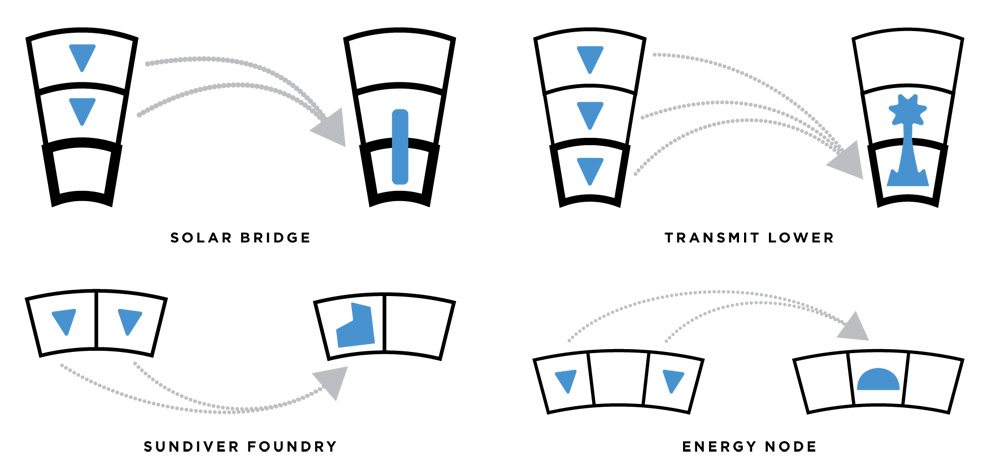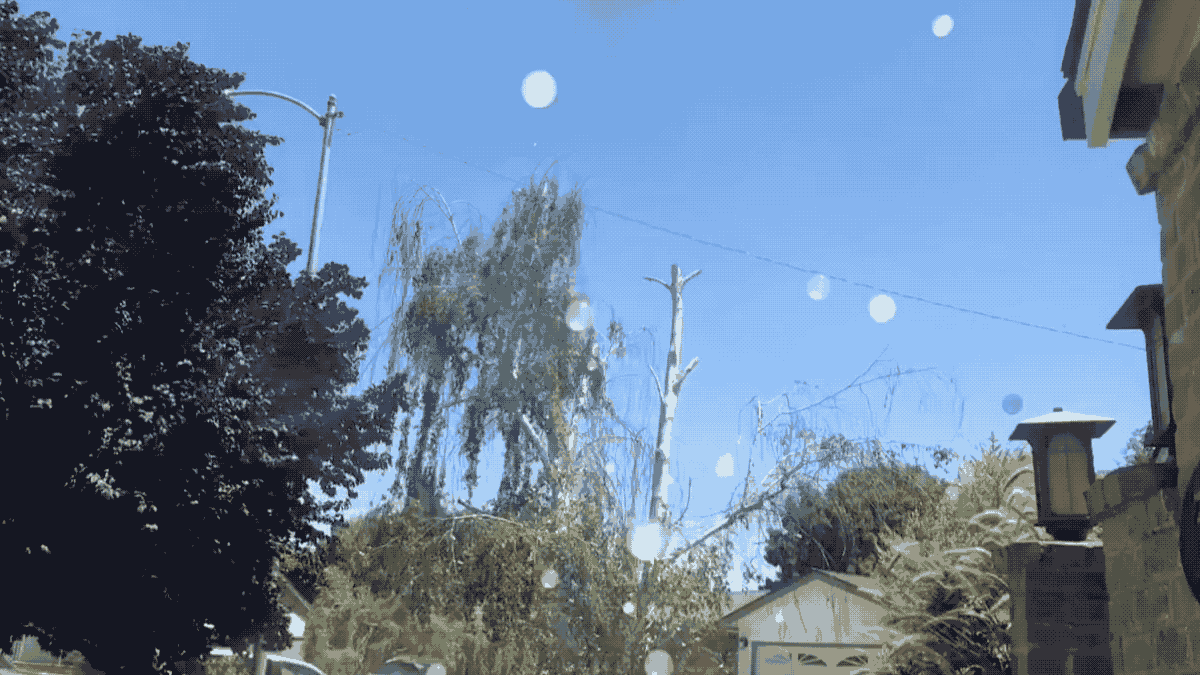Your sun is about to go supernova. You and the other worlds in the star system have built massive arks to save a small portion of your civilization, and you’ll harvest energy from what remains of the sun to power your arks. However, extracting this energy will hasten the star’s own destruction–can you escape before it’s too late?
At a glance: Sol: Last Days of a Star is a game from Elephant Laboratories for 2 to 5 players, ages 10 and up, and takes 45-90 minutes to play (depending on number of players). It’s currently seeking funding on Kickstarter, with a pledge of $59 for a copy of the game (or $10 for the Print and Play). The game doesn’t have anything inappropriate for younger players, but based on the length and nature of the game I would recommend it for more experienced 10-year-olds or slightly older players.
New to Kickstarter? Check out our crowdfunding primer.
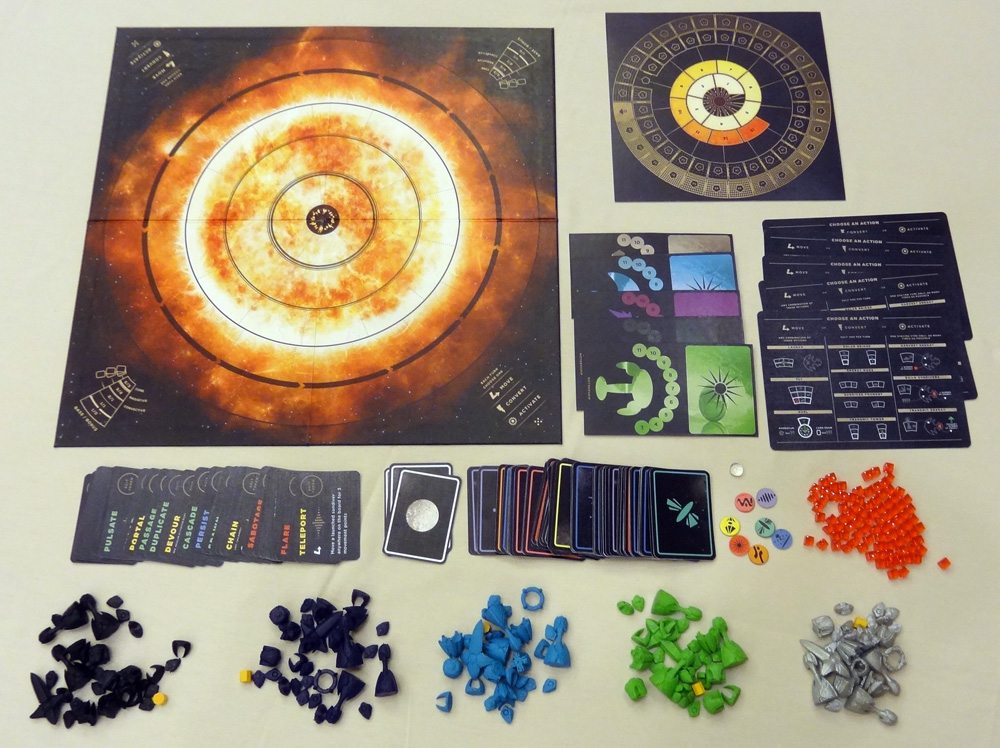
Components:
The game I played was an earlier prototype, and I got to see another prototype with updated graphics and components, so you’ll see both versions in this post. The photo above is the most recent prototype.
- 1 double-sided game board
- 1 Momentum/Instability board
- 1 Instability marker
- 34 Instability Effect cards
- 103 Instability cards
- 7 Instability suit tokens
- 89 Energy cubes
- 5 double-sided player boards
- 5 Player Aids
- 5 Motherships
- 5 Arks
- 65 Sundivers (13 per player)
- 25 Solar Bridges (5 per player)
- 15 Energy Nodes (3 per player)
- 15 Sundiver Foundries (3 per player)
- 15 Transmission Towers (3 per player)
- 5 Movement Trackers
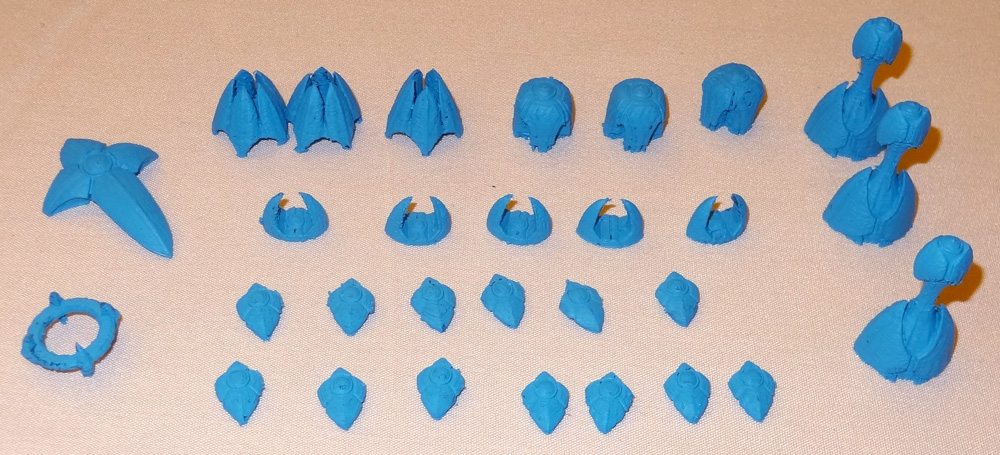
Ryan Spangler, one of the co-designers of Sol, brought over a prototype set to demo the game for me. Most of the art and design was finished, but the tokens (as you’ll see in the photos) were 3D printed plastic instead of the wooden bits that are planned for the finished game. As you can see, there are a lot of components in the game. The ones you’ll see in the gameplay photos are flat printed bits; the photo above shows a 3D print that’s closer to the final look that will be included.

The Instability Effect cards with the suit tokens are a way to mix up the game a bit. There are 7 suits, and for each game you choose some of the effect cards to use, placing the tokens on the cards so each one represents an ability. The Instability cards that you draw from the deck show only a suit symbol, so in each game you can have a different set of effects. Depending on which ones you choose, you could have a game with a lot more direct attacks on opponents, or ones that affect you instead.
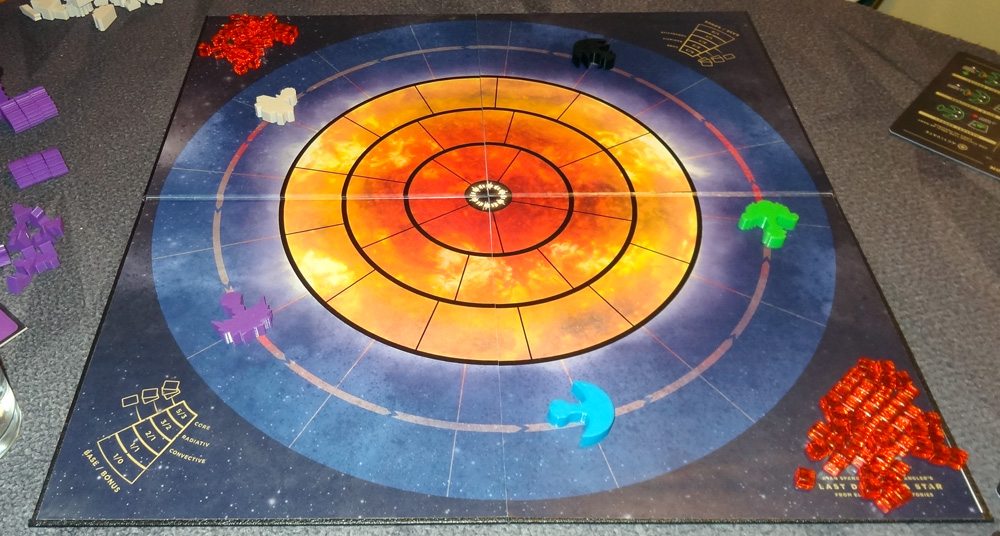
How to Play
You can download a PDF draft of the rules here.
The object of the game is to build up the most momentum on your Ark before the the sun goes supernova and everyone else dies a fiery death.
To set up, each player takes all the components for their world. The Arks are placed on the Momentum track at 0, the Instability marker is placed on 13 of the Instability Spiral, and the Energy cubes are placed in a supply on the corners of the board. Each player starts with 8 active Sundivers (placed on the player boards), and the rest are set aside in a supply. Each player also gets 3 Energy cubes, and the movement marker starts at 3 on the player board. The rest of the components are set aside, ready to be built.

The Motherships start equally spaced around the sun on the line between “Upper Orbit” and “Lower Orbit.” There will be one larger gap between two of the ships–that marks the active player.
Pick suits for the Instability deck–the more players, the more suits you will use, but you always include the red explosion suit–and shuffle the deck together. Then pick one Effect card per suit and place those on the table, with one suit token on each card.
On your turn, you take one of three actions, and then move your Mothership one space to fill in the gap:
- Move Sundivers around the board
- Convert Sundivers into Bridges or Stations
- Activate Stations with your Sundivers
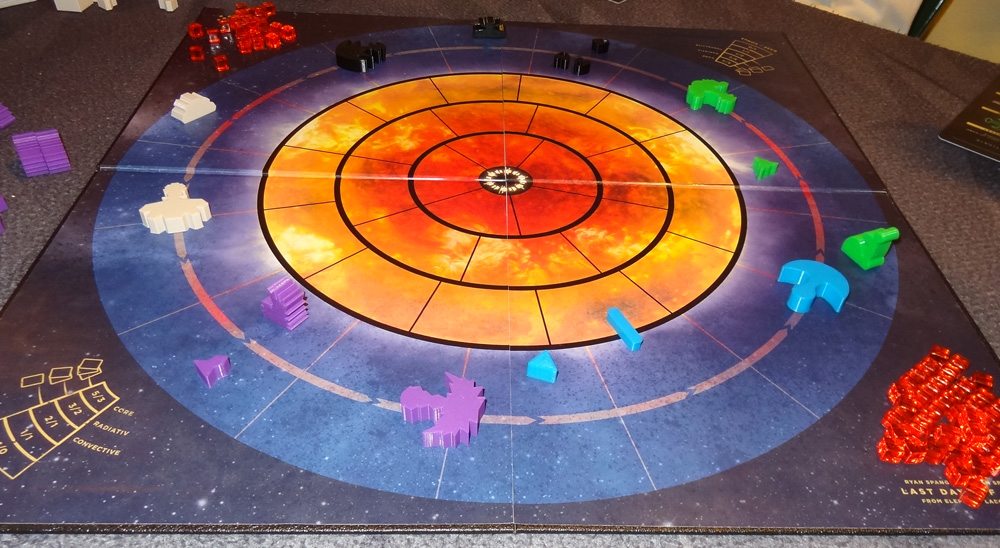
Move: Your Mothership just automatically orbits the star, one space per turn. You spend movement points to launch Sundivers into the four spaces surrounding your Mothership, and can then spend movement points to move around the board. You start with 3 movement points, and each time you build a Station, you get additional movement points for your Sundivers. Sundivers can move around in the two Orbit layers, but to cross the heavy black lines into the levels of the star, they have to use Solar Bridges. If you have Sundivers in the Core of the sun, you may also hurl them into the heart of the sun, permanently removing them from the game, but you gain 2 momentum for each Sundiver sacrificed.
In Sol, you may use any player’s Solar Bridges and Stations, but the owner gets a bonus. When you move across another player’s Bridge, that player gains an Energy from the supply (maximum 1 energy per turn, regardless of how many of that player’s Bridges are used). No bonus is given for using your own Bridges.
Convert: Sundivers can be converted into Bridges, Energy Nodes, Sundiver Foundries, and Transmit Towers when they form certain patterns on the board. The converted Sundivers go back into the reserves (not on your player board) and then the new structure is placed on the board. You may build one structure as an action, and you will draw cards based on the layer of the sun the new structure is in–the deeper into the core, the more cards you will draw.
When you draw cards, you will reveal them. Each time a red explosion suit is revealed, a solar flare occurs. You will move the Instability marker one step closer, and players with 13 or more Energy cubes will lose half of them. There’s also a bonus activation for any Stations in Upper Orbit. Finally, you choose one card to keep, placing it on your player board. The card may then be discarded on your turn to use the effect associated with that suit.
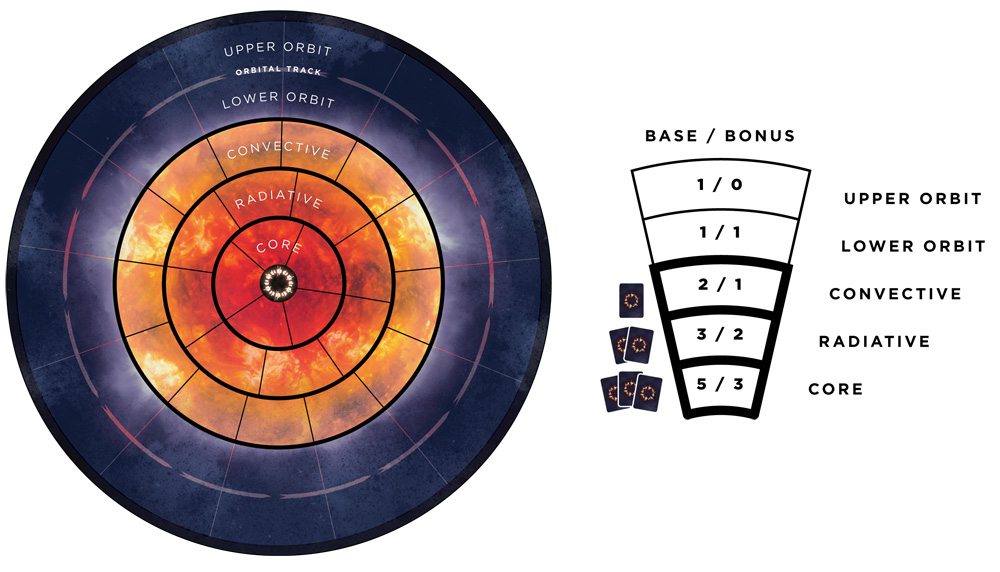
Activate: If you have a Sundiver in the same space as a Station (Tower, Foundry, or Node), you may use the activate action. You choose a type of Station, and then you may activate each of that Station type by returning a Sundiver from that Station to your player board. If you use a Station owned by another player, that player will get a bonus.
The three Stations are:
- Transmit Tower: spend Energy cubes to increase Momentum for your Ark.
- Sundiver Foundry: spend Energy cubes, gain Sundivers from reserve onto your player board.
- Energy Node: take Energy cubes from supply.
The amount of Energy you must spend or take depends on the layer of the sun that you’re in, and it’s all or nothing. In the Core, a Sundiver Foundry will take 5 Energy and build 5 Sundivers–but if you only have 4 Energy cubes, you can’t build just 4 of them. The Station’s owner gets a bonus to use, but it’s also all or nothing–if the owner cannot use the bonus, the active player may choose to take the bonus as well.
Activating Stations will also cause you to draw cards, possibly triggering solar flare effects.
End of turn: At the end of your turn, you orbit your Mothership one space, and it’s the next player’s turn.
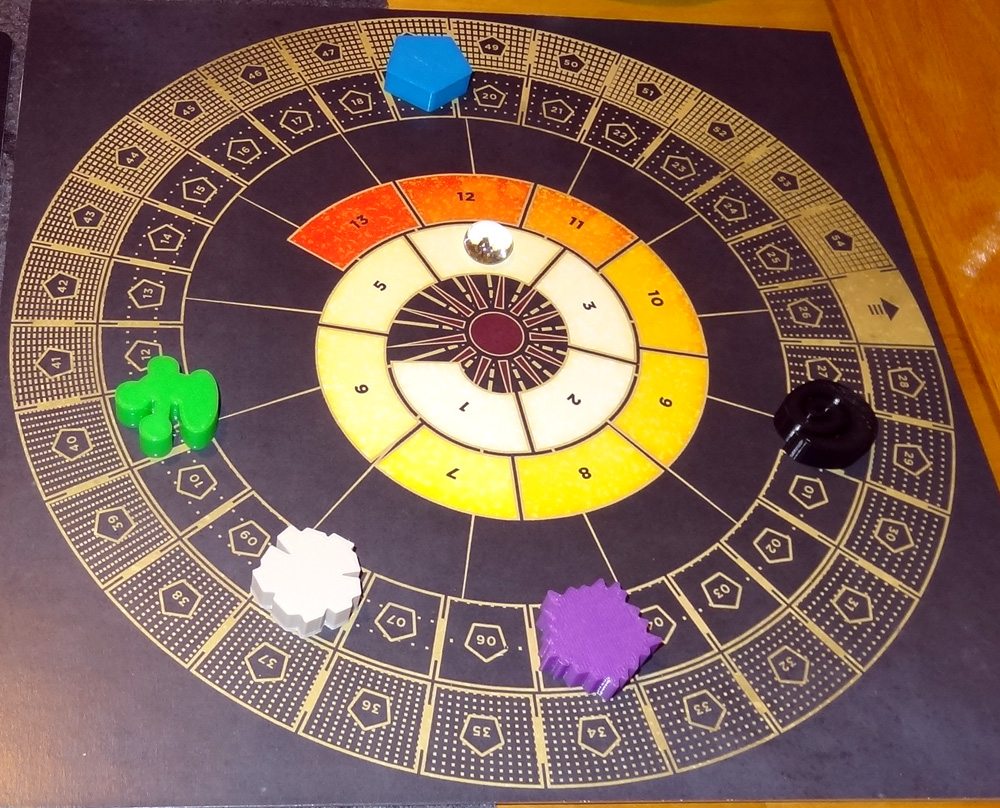
When the 13th Solar Flare occurs, the game immediately ends. The player with the most Momentum escapes the explosion and survives, and the rest, well, they weren’t so fortunate.
The Verdict
Sol: Last Days of a Star is the first game from brothers Ryan and Sean Spangler, and I think they’ve done a pretty great job with it. While a few of the mechanics seem familiar, the overall experience is a new one, and includes some ideas I hadn’t seen before.
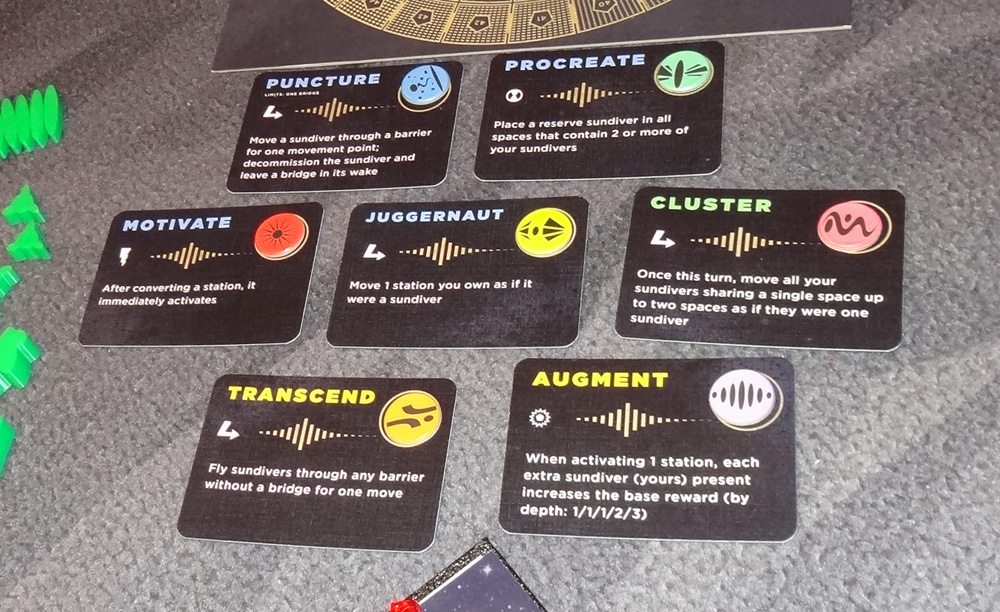
I like the use of the Instability Effects cards, which I’ve already mentioned above. It allows for a host of different card abilities, a different game each time you play, without the expense of dozens of extra cards. I particularly like that the effects are color-coded by type of effect. Blue cards are recommended for first-time players since they are simpler effects. Red cards are direct attacks and things that affect your opponents, and can be included if you want a lot more player interaction.
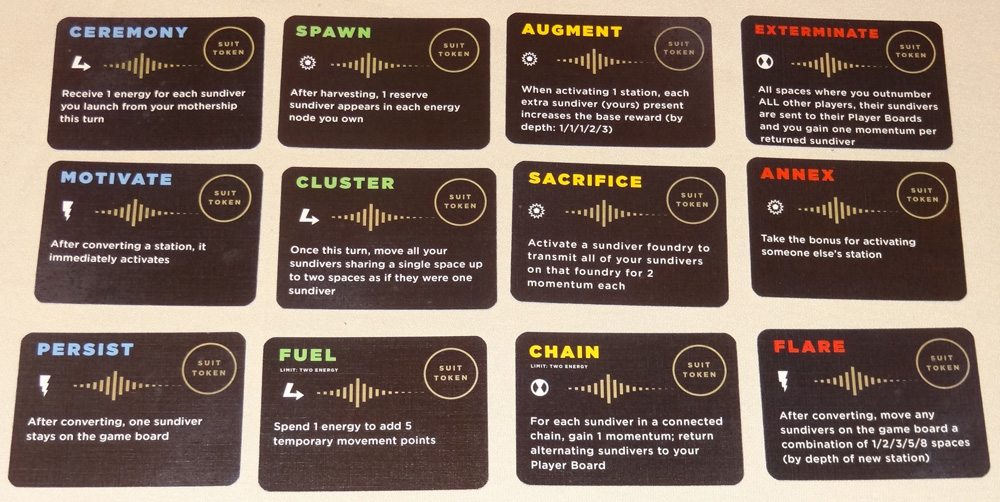
That said, even without the red cards, there is player interaction because of the way the structures work. It’s interesting that when you build things, anyone can use them. You have to make decisions about when to build a structure and when to just send your Sundivers to an existing structure. Is it worth the cost? How about the bonus your opponents will get if you use theirs? How many turns will it take you to move your Sundivers to their structure, compared to the number of turns it will take to recoup the converted Sundivers?
If you let others build bridges deeper into the sun, that may allow you to spend your own resources on more effective Stations deep in the Core–and when everyone wants to use your Stations, you reap the bonuses.
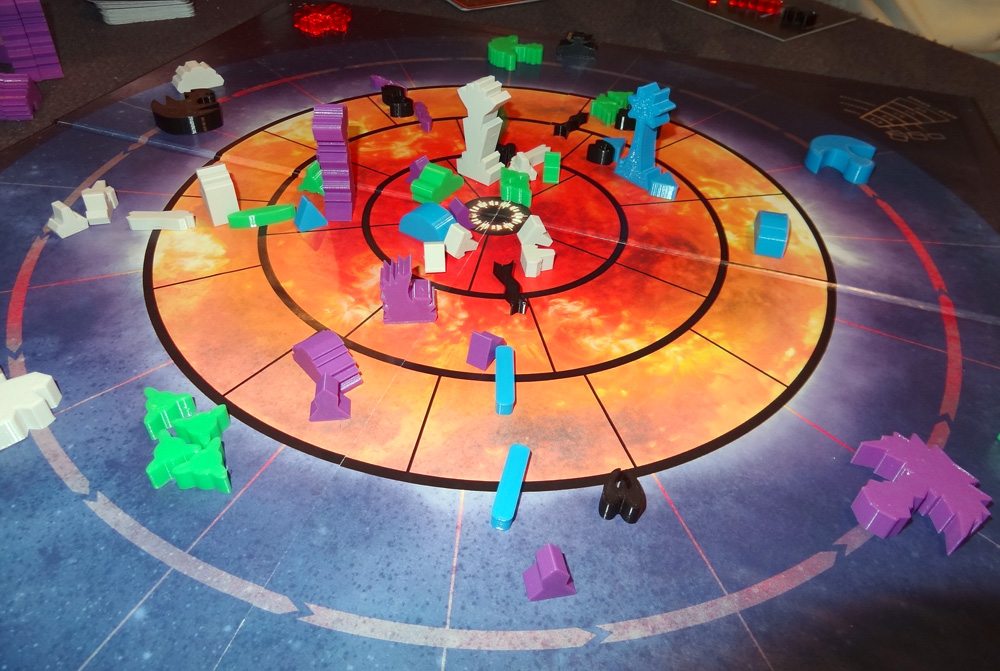
The instability aspect is also interesting–the more you build structures and use stations that are closer to the heart of the sun, the more cards you will draw, and the sooner the game will end. The beginning of the game starts off at a somewhat leisurely pace, but it feels more frantic by the end.
The orbiting Motherships are also a key part of the game (though also one of the easiest parts of the turn to forget). Newly placed Sundivers must be placed adjacent to your Mothership, but as you orbit the sun, you’ll end up far from the structures you built at the beginning of the game and much closer to those your opponents have built. Careful placement of bridges and other structures is beneficial both to you and your opponents, and you have to rely on each other (or waste an entire orbit to get back to your own bridge).
I’ve spoken with Ryan Spangler and Jodi Sweetman of Elephant Laboratories, and although this is their first Kickstarter campaign, I can tell they’ve done their homework, both in running a lot of demos and playtests of the game at various conventions and also getting advice from other designers and publishers who have been through the process. They’ve even pushed back the launch of the campaign in order to get things lined up to reduce delays in production. Of course, any campaign could run into unexpected delays, but I think you can feel comfortable backing this project and knowing you’ll get a nice finished product at the end of it.
I was only able to get one play of Sol myself as of this writing, but I had a good first impression and I’m excited to see where this one goes. The individual turn actions are not too complex in themselves, but figuring out your tactics for the entire game can be challenging and offers a lot of strategic depth. The instability effects allow for a lot of replayability. I would recommend it for gamers with at least some experience with strategy games.
For more information, check out the Kickstarter page.


